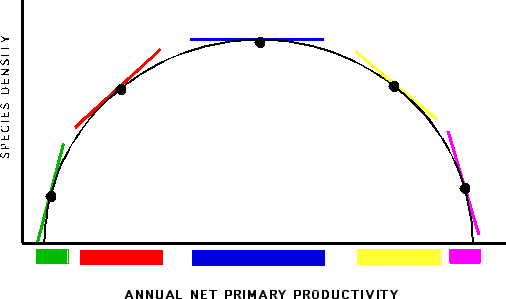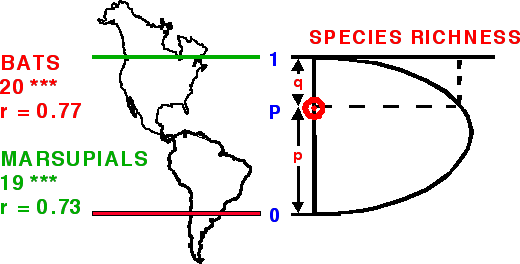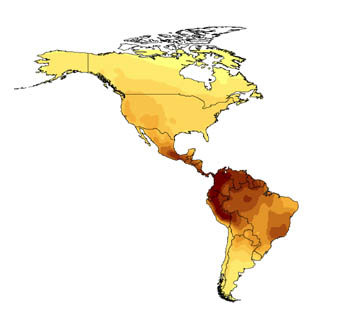Gradients of BiodiversityBroad-scale patterns in species diversity and
species range size are the primary components of
research within this focal area. My work has
increasingly emphasized the scale-dependence of
both pattern and process. As a consequence, I
have been involved with the development of theory
as well as with its empirical assessment in
natural experiments. Species Richness and Productivity.-In collaboration with Robert Waide, I organized a working group funded by the National Center for Ecological Analysis and Synthesis (NCEAS) to explore the relationship between productivity and diversity. The initial workshop comprised approximately 20 scientists representing a number of LTER sites, as well as other researchers with an interest in the topic. In a general way, the working group explored both the state of the theory and the quality of empirical data relating to theory. A subsequent working group of 8 scientists met on a number of occasions at NCEAS to advance synthesis based on considerations from the earlier workshop. As a result of those efforts, we produced publications in the Annual Review of Ecology and Systematics (Waide et al., 1999), Oikos (Gross et al., 2000), Ecology (Mittelbach et al., 2001), and Evolutionary Ecology Research (Scheiner et al., 2002).
Although a unimodal relation is cited frequently as the pervasive pattern, we found little evidence for a "general" relationship between productivity and diversity (Mittelbach et al., 2001) based on an exhaustive survey of the literature. Rather unimodal, negative linear, positive linear, as well as no relationship are all common. Much of the variation in pattern may be a consequence of the plethora of scales at which the research has been conducted. Based on theoretical considerations, we show that the relationship can be scale-dependent (Scheiner et al., 2000), and based empirical data from a number of low stature vascular plant communities, we show that the relationship is scale-dependent (Gross et al., 2000). Finally, we have integrated our conclusions, with those of the other participants in the working group, into the context of a dynamic and evolving theory (Waide et al., 1999). The receipt of a large grant from the Knowledge and Distributed Intelligence Program (KDI) at NSF continues to facilitate research concerning biodiversity and ecosystem function. It marshals expertise in computer science, informatics, and ecology to identify, analyze, and synthesize complex and heterogeneous data pertinent to the relationship between ecosystem function and aspects of biodiversity (http://knb.ecoinformatics.org/). My involvement in the group includes coordination of topical research by working groups that expand the scale and amplify the components of diversity which are considered in analyses. In addition, we have produced a distributed seminar series in which graduate students and faculty mentors from across the US, and now from South Africa as well, explore diversity-productivity relationships in grasslands and deserts, consider the role of invasive species, and incorporate aspects of disturbance regimes into a empirical analyses and model development (see Andelman et al., in review for Bioscience). Latitudinal Gradients of Diversity.-I have long been interested in the generality of the way in which species density increases with decreasing latitude. Initial work refined methodological approaches, and defined the form of the pattern for a variety of families of New World bats (Willig and Selcer, 1989; Willig and Sandlin, 1991). Subsequent work did the same for New World marsupials (Willig and Gannon, 1997) and mammals in general (Kaufman and Willig, 1998). A comprehensive synthesis of research on latitudinal gradients in biodiversity by my students and me is being revised for publication in the Annual Review of Ecology, Evolution, and Systematics (Willig et al., 2003). From a theoretical perspective, I developed a probabilistic model to show that gradients in diversity can arise as a consequence of stochastic processes, and that much of the observed gradient in New World bats and marsupials may be affected by chance rather than any of the numerous (~ 35) biological mechanisms that have been championed in the literature (Willig and Lyons, 1998). Indeed, the pervasive appearance of a pattern, regardless of taxon or geographic domain, may not be a consequence of a single biological mechanism. Rather the ubiquity of the pattern may be a consequence of different factors (historical, biotic, abiotic) affecting the northern and southern termini of species ranges, which taken together, give the appearance of a stochastic process (Willig, 2000; Willig et al., in review).
The bounded nature of geographic domains can lead to a seemingly deterministic pattern in the association between the size of species ranges and latitude (tropical species with larger ranges). In parallel work, we show that Rapoport's Rule (a latitudinal gradient of decreasing size of species ranges with decreasing latitude) is not observed in either New World bats or marsupials, rather the reverse pattern exists as a consequence of stochastic processes operating within the bounded nature of continents (Lyons and Willig, 1997). Despite the empirical increase in range size with decreasing latitude, we show that the decrease is not as great as would be produced by chance alone, and that the "spirit" of Rapoport's Rule is supported by empirical data.
In addition to examining gradients of species richness at large focal scales (i.e., latitudinal bands or quadrats), my doctoral student and I (Stevens and Willig, 2002) have documented hemispheric patterns of biodiversity at the focal scale of local communities. More specifically, we examined multidimensional taxonomic components of bioidiversity (species richness, evenness, dominance, and diversity) for 34 different New World bat communities. We showed that spatial variation in richness components is independent of those related to components of evenness. Moreover, species richness of local communities exhibits a significant latitudinal gradient, whereas species evenness is invariant with respect to latitude. Importantly, tropical increases in species richness at broad scales (gamma diversity) is much steeper than that at local scales (alpha diversity), suggesting that turnover among communities (beta diversity) increases toward the the tropics. |
Please contact steven.presley@uconn.edu or michael.willig@uconn.edu if you have questions, comments, or corrections. Unless otherwise indicated, figures, tables, and images that appear on this page may not be used, reproduced, copied, or posted elsewhere, for any reasons, without permission. |


 Finally, we provide one of the first
models to wed two biogeographic theories: species
area relationships and latitudinal gradients in
diversity (Lyons and Willig, 1999, 2000). We show
that the latitudinal gradient of species density
of both bats and marsupials is scale-independent
for areas between 1,000 and 25,000 km2
in the New World. Moreover, we find that at these
scales, area is of little consequence to
continental patterns, and latitude alone accounts
for 60% (marsupials) to 85% (bats) of the
variation in species density.
Finally, we provide one of the first
models to wed two biogeographic theories: species
area relationships and latitudinal gradients in
diversity (Lyons and Willig, 1999, 2000). We show
that the latitudinal gradient of species density
of both bats and marsupials is scale-independent
for areas between 1,000 and 25,000 km2
in the New World. Moreover, we find that at these
scales, area is of little consequence to
continental patterns, and latitude alone accounts
for 60% (marsupials) to 85% (bats) of the
variation in species density.